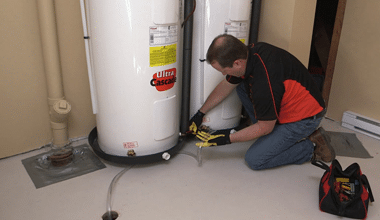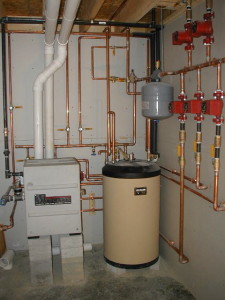Key Steps for Residential Property Owners Dealing with Faulty Hot Water Systems
Key Steps for Residential Property Owners Dealing with Faulty Hot Water Systems
Blog Article
What are your thoughts and feelings on Water Heater Burst?

Whether it is located in the basement or a separate space, busted water heaters can create stress. Having no warm water supply is also problematic.
Call the Plumber
After doing the initial two safety and security steps, you must call your plumber ahead today to fix a ruptured water heater. Remember that your unit will not just conk out dramatically overnight. There are typically indications that your aging water heater has debris buildup in the interior. Take note of the following:
Instead, as soon as you spot these indications, have actually a professional come to evaluate your water heating system tank. Typically, water heating systems have a lifespan of about 8 to 12 years.
Cut Off the Cold Water Supply
Cut off the tanks touch water supply from the resource. When your storage tank is in great problem, the chilly water stops filling up when the storage tank is complete. If you can not find it or reach it, you need to transform off that main water supply line outside your residential property.
Shut Down Power Source
Prior to calling the plumber, shut off a gas water heater by transforming the temperature level dial. This is normally found on top of the thermostat. Switch over off the circuit breaker if you have a design that runs on electric power. This will certainly avoid electrocution, particularly if there is a leak as water is a conductor. Commonly, the heating element shuts down when the water hits a specific temperature level. With a broken tank, it might malfunction. Sufficing off ensures you stay safe.
Clean Up Residential property
After calling the plumber, document damages by keeping in mind and pictures so you can claim your homeowner's insurance. From there, begin the instant cleaning. Secure any type of crucial personal belongings to avoid more soaking. After that, remove any kind of standing water to prevent mold and also mildew development. If you have a submersible water pump, utilize that to drain the water. Or else, the standard bucket technique will certainly likewise function. Attempt to mop out every little thing, consisting of walls and wall surfaces. If you have an electric fan and also dehumidifier, maintain them running to maintain air circulating. This will aid deter mold and mildew development.
Remember, if you see any kind of concerns with your water heater, call the pros immediately. You can not take this trouble gently since a faulty thermostat can raise water temperature to a dangerously high level, leading to unintentional burns. A broken heater pressure relief valve can additionally cause an explosion. For best results, get a yearly check so your device obtains evaluated, cleaned, drained, and re-filled, guaranteeing optimum performance.
After doing the initial two security actions, you need to call your plumber to come right away to take care of a ruptured water heating unit. Rather, as quickly as you detect these signs, have actually a professional come to examine your water heating system tank. Prior to calling the plumber, closed off a gas water heating unit by transforming the temperature dial. If you have a completely submersible water pump, use that to drain the water. Remember, if you discover any issues with your water heater, call the pros right away.
8 REASONS YOUR HOT WATER HEATER IS NOT WORKING & HOW TO FIX
Water Heater Problems & Solutions
Loose or Damaged In-Line Valve
Unlike a water leak near the bottom of your water tank, a water leak on top of your system can be easily fixed. A common cause of water tank leaks includes a loose in-line valve. This is a handle that is located at the top of the water tank that is engineered to activate or deactivate the flow of water. To fix this problem, you will need to secure the nut that holds the ball or in-line valve in its location. If the leak becomes more severe once it is tightened, you will be required to travel to your local hardware store to purchase a new in-line valve for your water heater.
Damaged Pressure Relief Valve
Most types of water heaters are equipped with a pressure relief valve that is engineered to discharge pressure from the water tank when it becomes too high. If this valve on top of your water heater begins to leak, we recommend purchasing a new one online or from your local store. The process of removing and replacing pressure relief valves is not complicated.
No Warm Water
If you have an electric water heater in your home, the most typical cause of a lack of warm water is a broken heating element. Your water heater is equipped with two heating elements that are tasked with heating incoming water in the water tank. Once a heating element begins to malfunction, you will have little to no hot water to use for showering, cleaning, and laundry.
Low Supply of Hot Water
Are you continuously running out of warm water? This issue may be a byproduct of a cracked dip tube. This tube is engineered to push cold water to the base of your water tank to be heated. Once a crack or hole begins to form in the dip tube, the incoming supply of cold water may be released near the top or middle of your tank. As a result, the cold water on top of the tank will be sent to the faucets and showers in your house. This hot water heater problem can only be fixed by replacing the dip tube on your system. Since the process of installing a new dip tube is complex, we recommend calling a certified technician for help.
A low supply of warm water may also be a signal of excess sediment buildup in your water tank. As your water heater reaches the middle of its life cycle, minerals in water including magnesium and calcium will begin to collect at the base of the water tank. As the minerals continue to grow, there will be less room in the water tank to store hot water. To resolve this problem, flush your water heater to remove the excess minerals.
Water is Too Warm or Cold
If the water in your shower feels uncomfortable hot or cold, you can adjust the temperature of your water by changing the settings on your thermostat. Setting the temperature to 120 degrees Fahrenheit may help you save money on your utility bills. This is an excellent temperature to use if you’re worried about scalding or skin irritation. Does this temperature feel too cold? You may also adjust the thermostat to 140 degrees Fahrenheit to make your showers more pleasant. If your hot water heater is not working when you change the temperature, this is an indicator of a broken thermostat. Immediately find a certified plumbing or heating contractor in your area to repair or replace your thermostat.
Low Water Pressure
Low water pressure is not always caused by a malfunctioning water heater. If you live in an older home with smaller water pipes, the flow of water will be restricted prior to reaching our kitchen or bathroom skins. The only way to eliminate this hot water heater problem is to connect new ¾-inch water lines to your system. Another type of problem that may negatively impact your water pressure includes calcium deposits in water pipes.
As magnesium and calcium begin to form in your pipes, the diameter of your water lines will become smaller. As a result, the warm water from your water heater will not be able to travel in an efficient manner to your sinks or appliances. Since the process of replacing water pipes includes removing drywall, an average homeowner that does not have a plumbing license will not be able to fix this hot water heater problem.
https://www.wmhendersoninc.com/blog/8-reasons-your-water-heater-is-not-working-how-to-fix/

I'm certainly very excited about Maintaining & Draining a Water Heater and I really hope you enjoyed the entire page. Sharing is nice. Helping people is fun. Thanks a bunch for your time. Visit again soon.
Premium service for plumbing emergencies. Report this page